The rest of the story.
Two days ago I posted a single photo of a young Short-eared Owl rotating ‘his’ head to an extreme angle while he was using motion parallax to pinpoint where the sound of my clicking camera was coming from. At the time I said that I’d post more photos of him when I’d had the opportunity to review and process more of my images. Today I’m keeping that promise as I tell more of the story.
All photos are presented in the order they were taken.
It all started out with me doing something pretty unusual for me. As I approached the spot where I’d cut Galileo, the fledgling Short-eared Owl, out of a barbed wire fence six years ago I decided to stop at that location and relive the experience (don’t ask me why. I couldn’t give you a logical answer). From where I stopped, the patch in the barbed wire was only a few feet outside my pickup window and the sagebrush that one of Gaileo’s parents had been perched in as it watched it’s offspring hanging from the wire was about 40′ in front of my pickup.
Suddenly, just as my pickup was rocking back to a full stop, two Short-eared Owls flew out of the sagebrush right in front of me, the one that Galileo’s parent had been in six years ago. I believe both owls were recent fledglings. I know one of them was because I spent the next 14 minutes with him. The other one flew much further away.
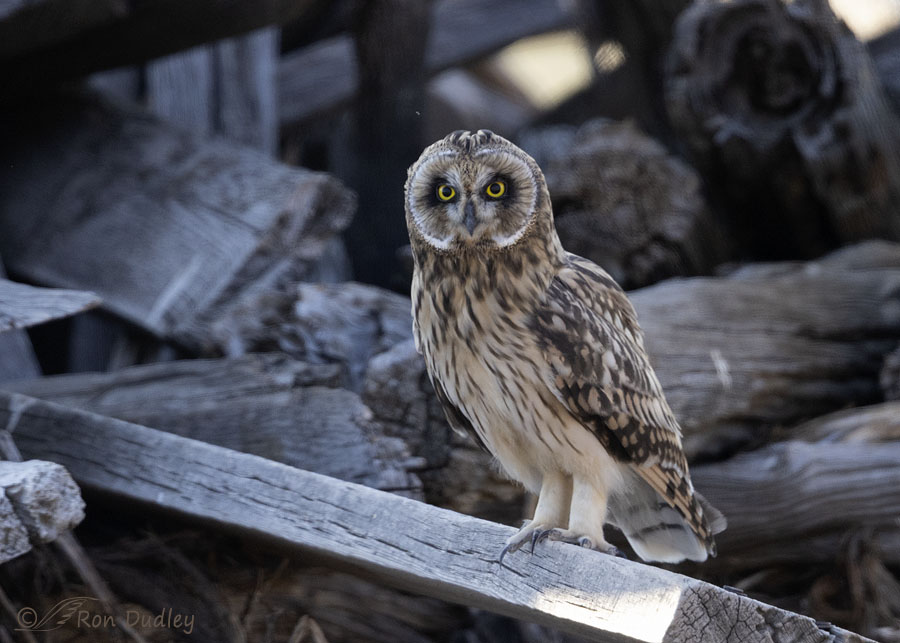
1000, f/5.6, ISO 1600, Canon R5, Canon EF500mm f/4L IS II USM + 1.4 tc, not baited, set up or called in
But this guy landed at the base of an old woodpile that was reasonably close to me. The woodpile was strongly backlit but the young owl was in shade in front of it so I still managed to get some pretty decent photos. But I knew that action shots would be a problem because I didn’t have much shutter speed, even after cranking my ISO up to 1600.
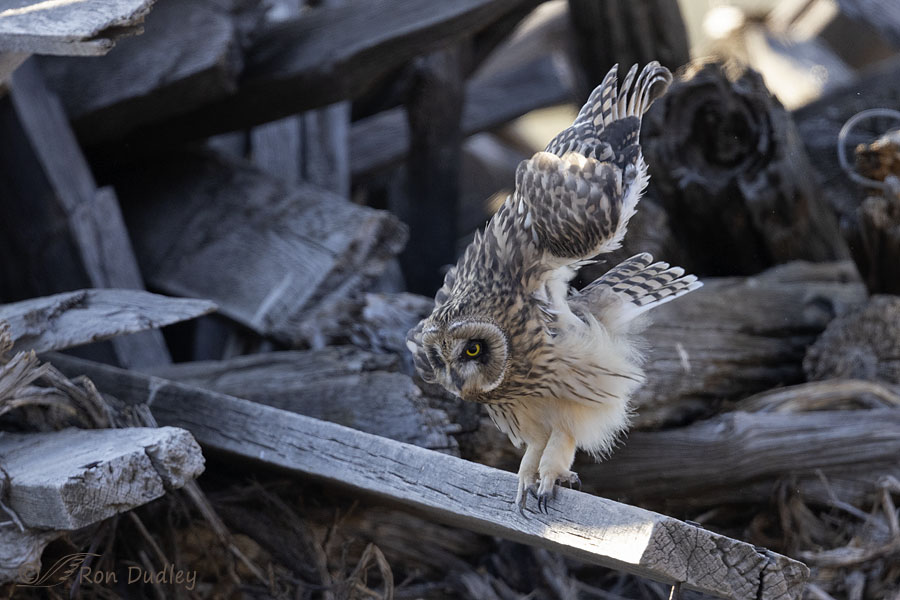
1000, f/5.6, ISO 1600, Canon R5, Canon EF500mm f/4L IS II USM + 1.4 tc, not baited, set up or called in
He was young enough to still be pretty clumsy so when he shook his feathers (roused) after preening he nearly fell off his perch.
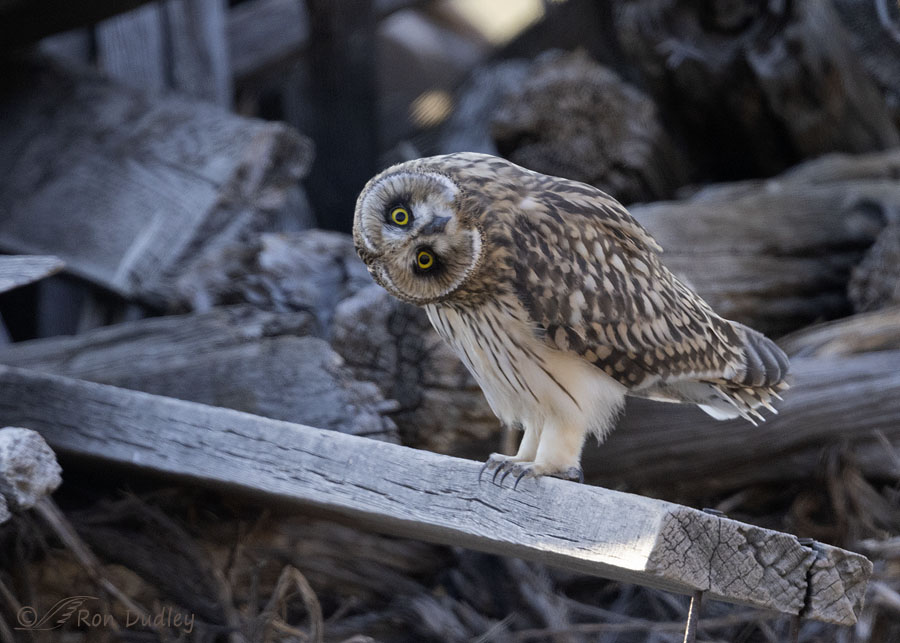
1250, f/5.6, ISO 1600, Canon R5, Canon EF500mm f/4L IS II USM + 1.4 tc, not baited, set up or called in
He was completely calm and relaxed in my presence but man, was he ever curious about me and about the shutter sounds coming from my camera. During the time I spent with him he was paralaxing in my direction much of the time. He’d rotate his head one way and then…
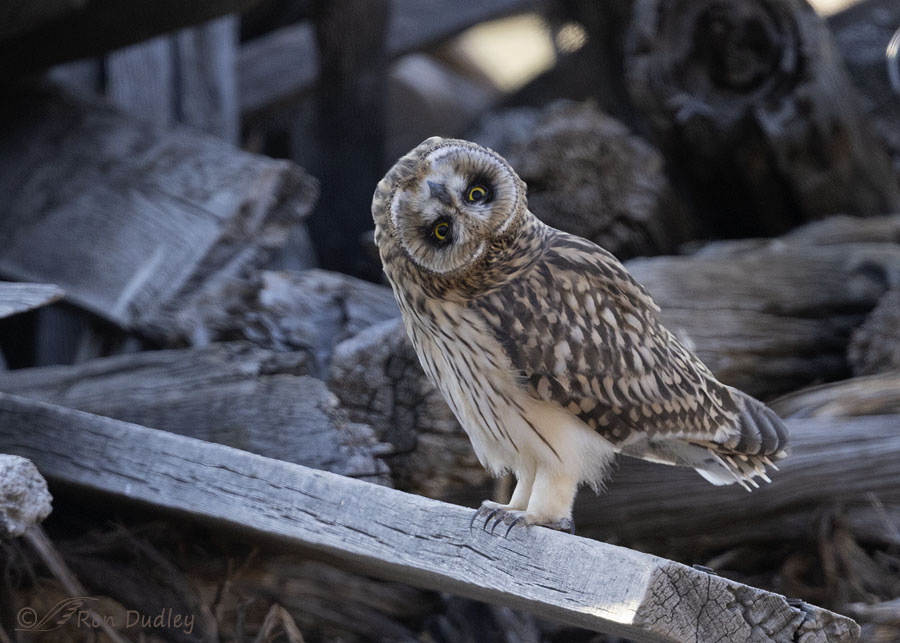
1250, f/5.6, ISO 1600, Canon R5, Canon EF500mm f/4L IS II USM + 1.4 tc, not baited, set up or called in
the other.
Suddenly I saw his attention go to something behind me.
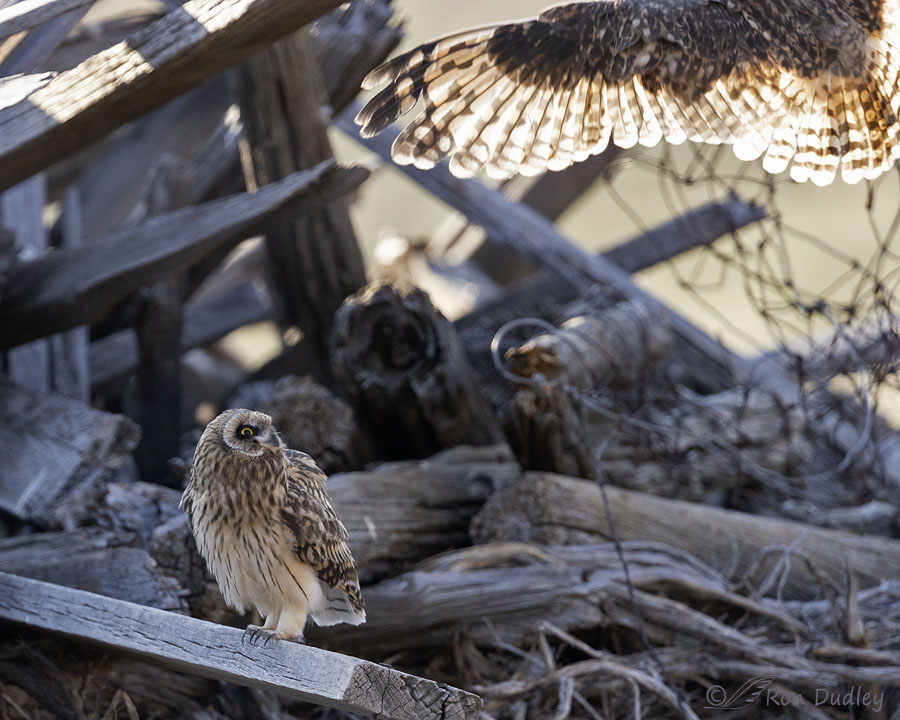
1250, f/5.6, ISO 1600, Canon R5, Canon EF500mm f/4L IS II USM + 1.4 tc, not baited, set up or called in
It was one of his parents coming in to check up on him. Now you see how strongly backlit the scene was.
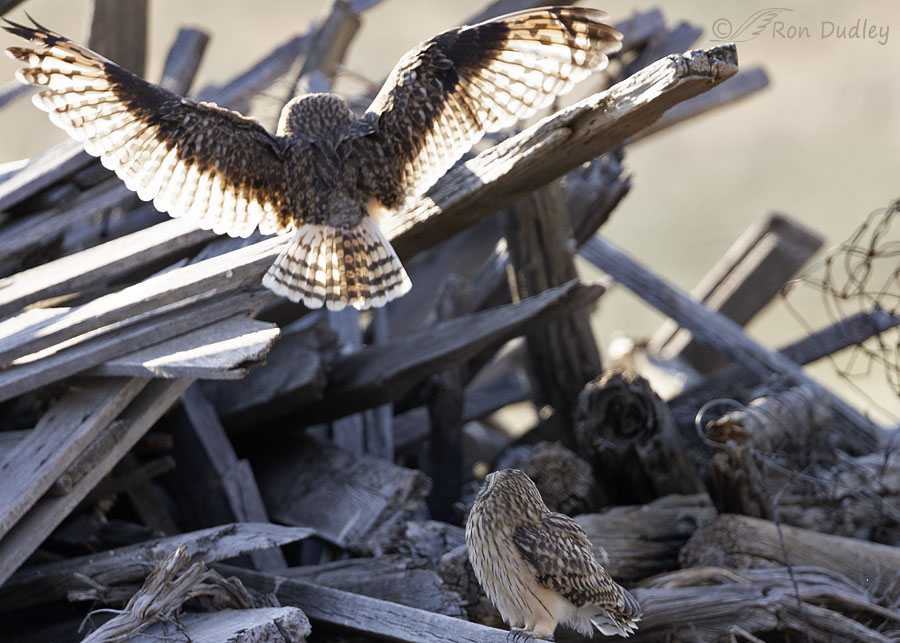
1600, f/5.6, ISO 1600, Canon R5, Canon EF500mm f/4L IS II USM + 1.4 tc, not baited, set up or called in
The adult landed near the top of the woodpile and behind the youngster.
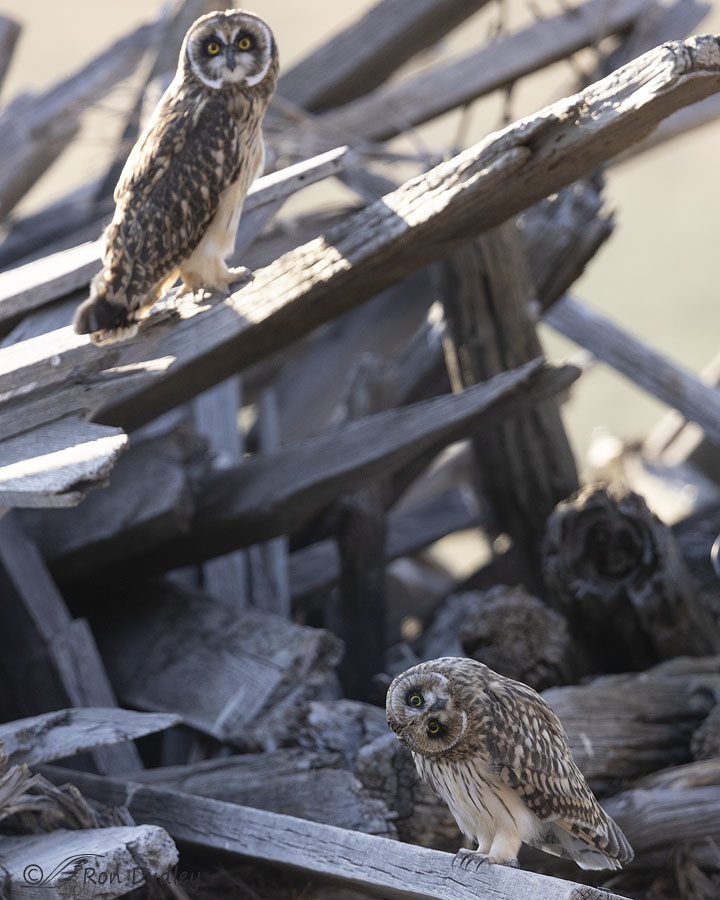
1000, f/5.6, ISO 1600, Canon R5, Canon EF500mm f/4L IS II USM + 1.4 tc, not baited, set up or called in
I barely had enough room in the frame to avoid cutting off body parts of one or both birds. The adult was strongly backlit so I spent most of my time photographing the youngster.
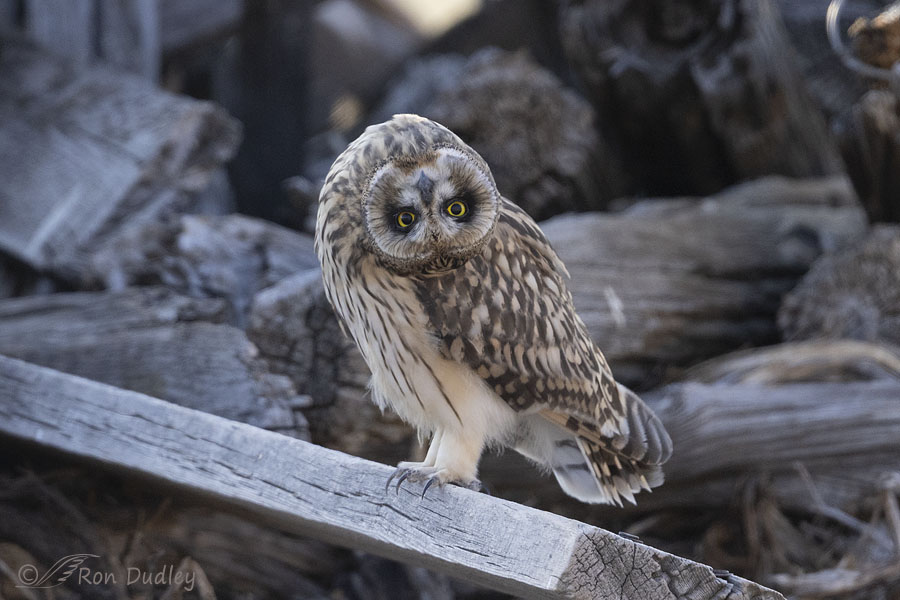
1250, f/5.6, ISO 1600, Canon R5, Canon EF500mm f/4L IS II USM + 1.4 tc, not baited, set up or called in
This is the photo I posted two days ago. Today I’m going to do something I probably should have done then.
Here his head is almost completely upside down and quite a few readers said that they had a hard time seeing that. For example, one commenter on Facebook said she “thought that was a horn in the middle of his forehead”, implying that his head looked right side up, just different. Others made somewhat similar comments.
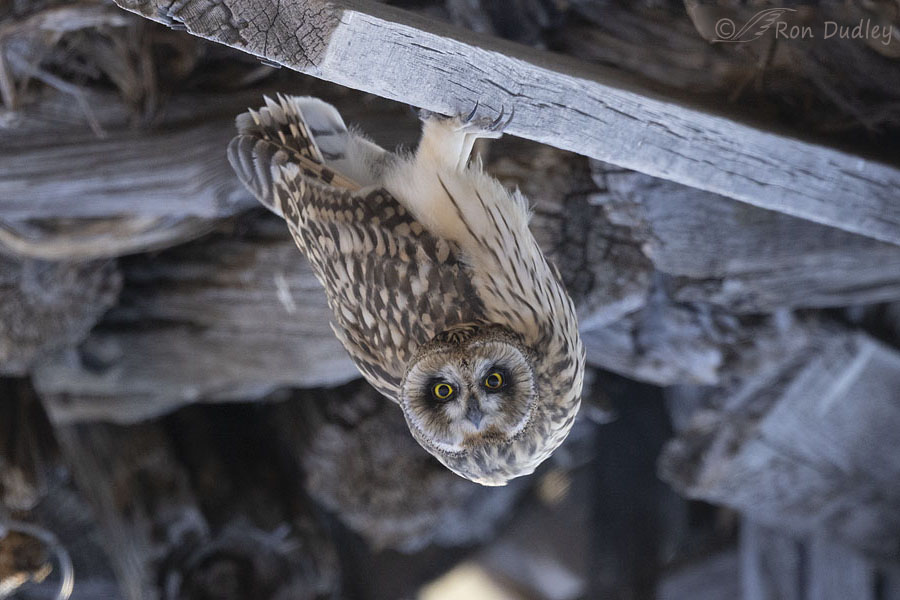
So, here’s the same image, rotated 180°, with the bird upside down but his head right side up. Kinda changes the perspective, doesn’t it.
Not long after this photo was taken he turned around on his perch, faced the other way, and kept staring at the sagebrush in front of me, the one he’d been perched in a few minutes earlier. I began to wonder if he was going to fly back to the sagebrush.
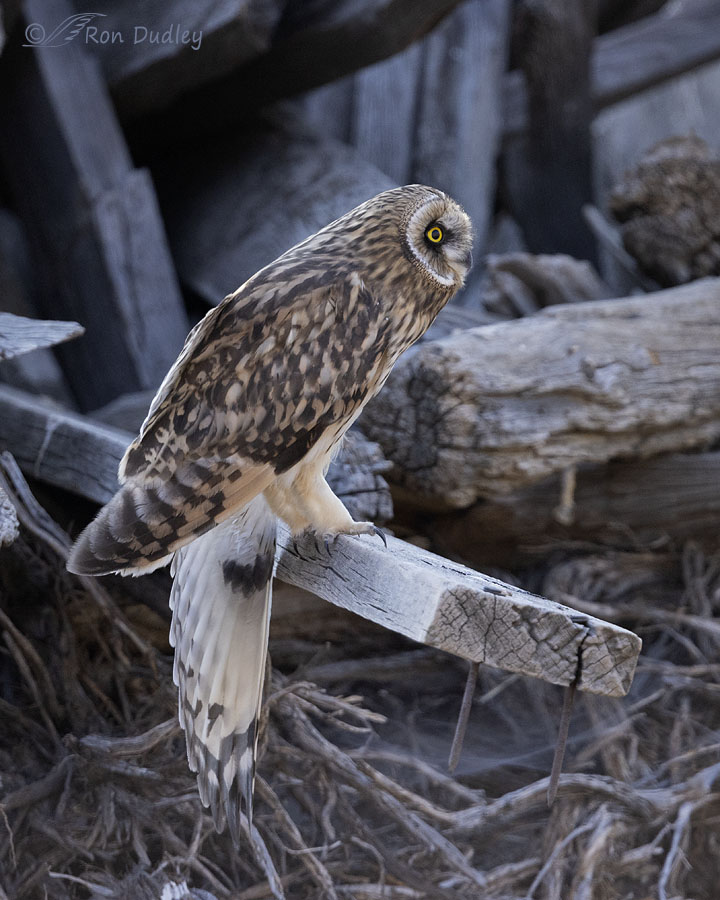
1250, f/5.6, ISO 1600, Canon R5, Canon EF500mm f/4L IS II USM + 1.4 tc, not baited, set up or called in
When he stretched his left wing while staring at the sagebrush I became convinced that’s exactly what he was going to do. But if and when he did, I knew I’d be screwed because I didn’t have enough shutter speed to get him sharp in flight and I was probably too close to him to avoid cutting off body parts with his wings out.
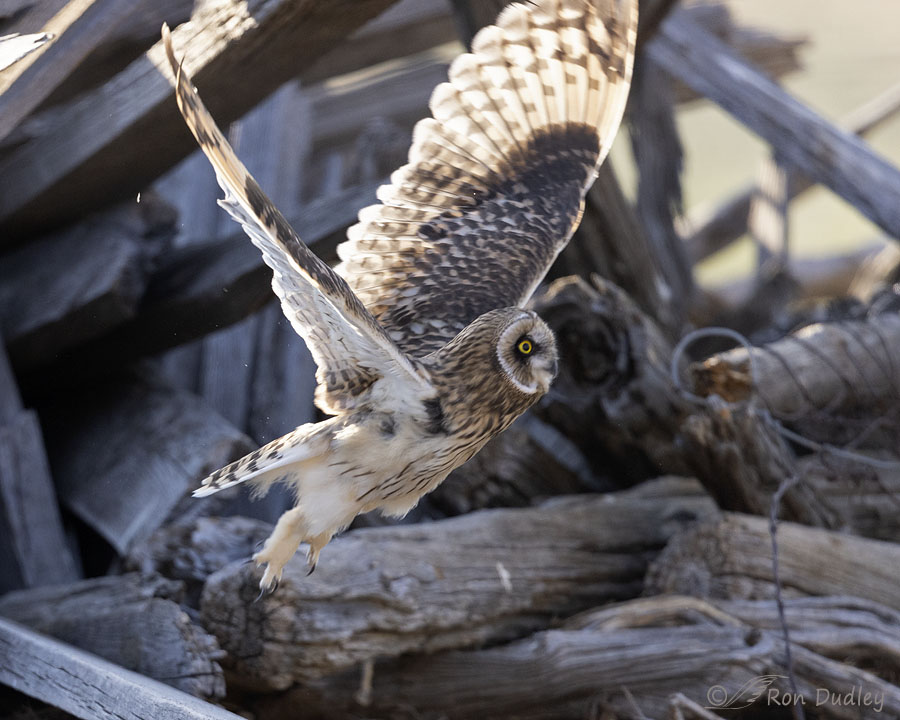
1250, f/5.6, ISO 1600, Canon R5, Canon EF500mm f/4L IS II USM + 1.4 tc, not baited, set up or called in
I was right on both counts. The bird is soft and I clipped a wing but at least this shot documents that he took off in the direction of the sagebrush.
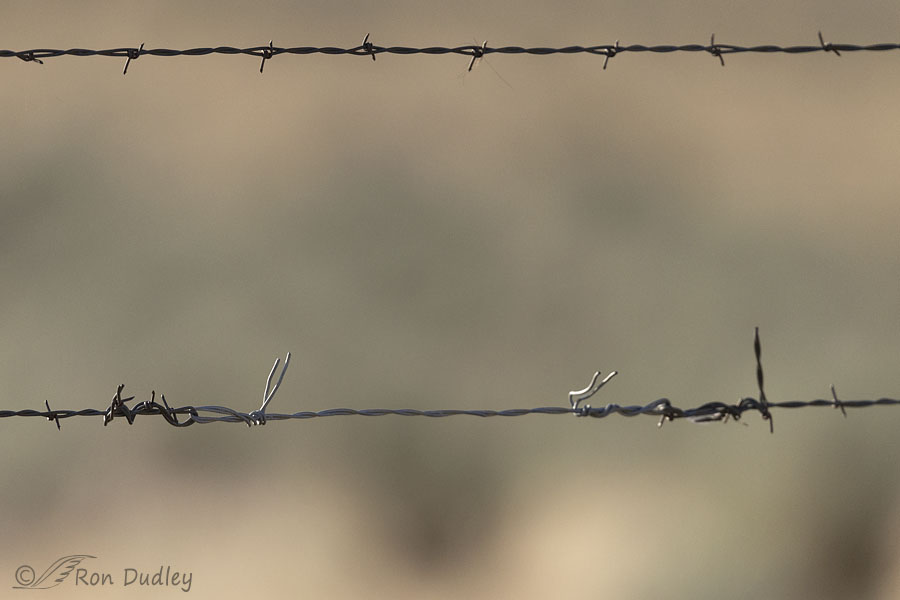
Before I drove forward toward the sagebrush to see if I could locate him again, I took a quick photo of the patch in the barbed wire I had to cut six years earlier in order to get Galileo off of the barbed wire. I guess I wanted to document how close I was to the site of Galileo’s terrible predicament.
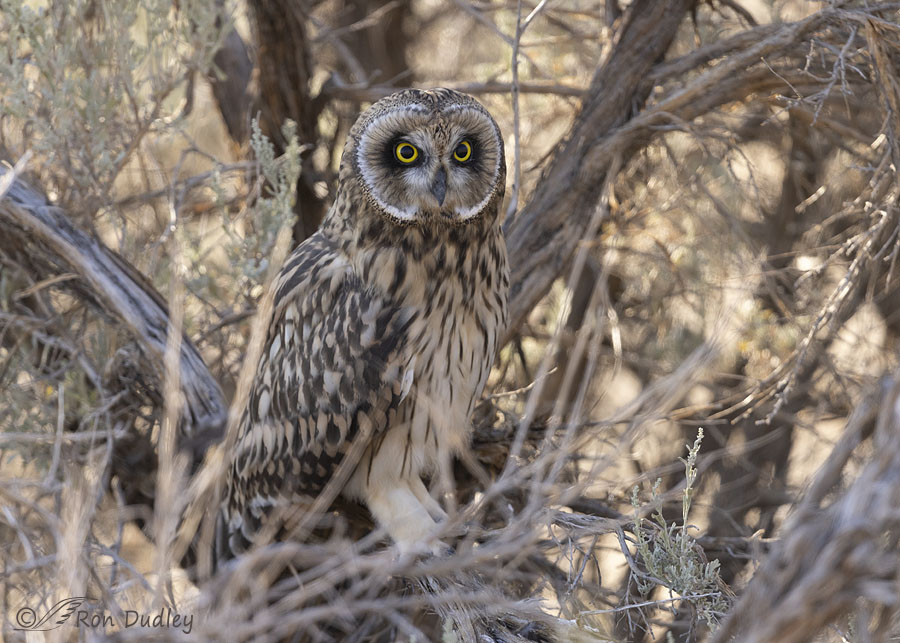
1600, f/5.6, ISO 1600, Canon R5, Canon EF500mm f/4L IS II USM + 1.4 tc, not baited, set up or called in
Here’s the youngster, back in the sagebrush he and his sibling flew out of a few minutes earlier. At this point I figured I’d spent more than enough time with him and I should leave him in peace, so I drove down the road to look for other birds. When I returned about 90 minutes later, I couldn’t find hide nor feather of any of the three owls.
All morning I was struck by how unusual it was to find the family of owls in the same place we found Galileo and his parent six years earlier, especially in such a vast landscape.
Just goes to show, what goes around comes around.
Ron
Notes:
- Today Galileo is an education bird for HawkWatch International. Even after months in rehab his wing was too damaged by the barbed wire for him to be released back into the wild. HWI named him Galileo. I visit him occasionally at HWI, at least I did before the pandemic.
- I could tell by the behavior of both owls that I wasn’t making them nervous or stressing them. If I had noticed signs of nervousness I’d have left immediately. For example, both owls spent significant time preening on the woodpile, which they don’t do when they’re nervous.


Ah, just have to add my appreciation. A couple of these are really breathtaking! Thank you so much for sharing!! We were on the beach in Rhode Island yesterday where we had a delicious swim and watched some seagulls! Best wishes, Mary
Absolutely marvelous serious of photos. They are so gorgeous! And your posts and Mia’s posts are thoughtful and educational and have enriched so many lives!
So grateful to you both
Wonderfu; series Ron! 1thanks for sharing!
Charlotte Norton
What a delightful series of the Shortie youngster and his “mama.” I especially like the shot where they’re both looking at you — the youngster is trying to figure you out, but the adult’s got your number.
I was kind of hoping that the adult would be Galileo’s parent, but too many years have elapsed (how can it be 6 years already?). Maybe this adult is one of Galileo’s siblings.
“how can it be 6 years already?”
I know what you mean, Marty. But I cut him out of the wire on the morning of June 19, 2016. I checked.
My stony heart has melted at these images. Again.
Thank you. So very much.
Ha, maybe that’s partly because your heart wasn’t stony in the first place, EC.
I guess if the owls are returning conditions must be good for them in that location. I love the upside down photo, it made me laugh. I did not have trouble with the turned head, I guess I have been around owls enough to make heads and tails of the image. I hope to never find another owl caught on barbed wire, it is very upsetting. I have a hard time driving past the area I cut down an owl without the image popping into my mind. I think owls seem to get hung up more than other birds due to the way they fly over the ground low and are looking down not forward. It also seems to be young owls are caught more often than adults too.
” I think owls seem to get hung up more than other birds due to the way they fly over the ground low and are looking down not forward”
April, I’ve wondered why I’ve never seen a harrier caught on wire but I have seen a fair number of owls. Harriers fly a lot like you describe and there are a lot more of them.
Watch harriers fly. I think they look up more. I have also watched them fly parallel to fence lines more then lift up and over quickly, they seem to know the boundary.
I dunno. And harriers generally hunt very close to the ground. Have you ever found a harrier snagged in barbed wire? I haven’t. Given how many of them there are, compared to owls, I’m surprised.
Maybe part of it is that owls tend to hunt more in low light when it’s harder to see wire especially.
Ron, I can remember well when you cut Gallileo loose from the Barbwire. I’m delighted to see these follow-up photos! Absolutely beautiful, and heartwarming, as well. Realism aside, it looks like all of your good work and goodwill “came home to roost“ in this instance.
Thanks, Alison. Whatever it was I was flabbergasted when those two owls flew out of the sagebrush in the same spot Galileo and his parent had been six years earlier. Especially because I was thinking about Galileo the very moment it happened.
Ron, this has been a week of amazing work from you! Wow, wow, wow!
The backlit parent flying in – that’s where we get our angel images from. The whole parent owl is gorgeous, but the one with just its wing in the upper right corner is somehow more dramatic – a teaser of what’s to come. And the expression on the baby’s face “I’m gonna be able to do THAT?” Thank you, thank you!
Carolyn, you’re right, it’s been quite a week. But it’s also meant a lot of work on the blog posts. I think I’m gonna slow down a little…
Totally awesome! The young’un is delightful to look at no matter what position he’s in, and the adult’s backlit wings are gorgeous. So glad you had that time with these owls in a place that has got difficult (but ultimately positive) memories for you. It was meant to be! ♥️
Thank you, Chris. Maybe it was.
As well as the barbed wire tangle in that woodpile I spied at least 4 tetanogenic nails – I am pretty sure Ron that you don’t need this piece of advice but here it is – get a tetanus booster before you go crawling around in that nasty space. Oh, and adorable owls!
I don’t go crawling around in it, Frances. Not even for birds. Besides, it’s on private land.
Flipping the head turn photo is brilliant!! Love this series.
Then I’m glad I included that upside down photo, Kathleen. I almost didn’t.
Clipped wings. No eye catches. Insufficient shutter speed. And yet, all the photos are wonderful, as is your narrative. I guess sometimes the rules are meant to be broken.
That wing stretch is impossibly long. Looks like the feather version of a hair extension.
The best part of the barbed wire photo is the section without any barbs. That’s a repair I can appreciate.
“The best part of the barbed wire photo is the section without any barbs.”
I noticed that too, Lyle. I guess whoever repaired it didn’t want bloody hands!
The other interesting thing is that we can probably see the actual barb that snagged Galileo’s wing.
Any time spent with Short-eared Owls is special. This represents an especially nice time. Thanks for sharing.
Glad you enjoyed it, Dan. Thanks.
I hope the parents were part of Galileo’s DNA family. The Floof and fall made me giggle.
“I hope the parents were part of Galileo’s DNA family.”
I suppose it’s possible, Arwen.
A true delight. Thank you!
Thanks, Kathryn.
Prime location or synchronicity? In a practice, day after day, year after year, we can find ourselves in a rhythm with nature unlike any other. We are gently transported – albeit temporary – out of our world and into theirs. It’s a beautiful gift, and you generously share a bit of it with us in these photo essays that you do so well.
That 3rd photo is so whimsical it made me chuckle out loud. So too is the upside-down version of the previous post. Was touched by the inclusion of the patched fence; a monument and visual metaphor.
Very grateful to you Ron.
“Prime location or synchronicity?”
Possibly a little of both, Michael.
I’m glad you enjoyed both the upside-down photo and the one of the patched fence.
Wow Ron, that was absolutely stunning! Thoroughly enjoyed that story. This is probably a stupid question but is there any chance that these owls you are seeing now are offspring (several years later?) of Galileo and his family? Given their affinity for that same area, I just have to wonder.
There’s no chance that he’s offspring of Galileo, Connie. Galileo was a fledgling when he was injured and he hasn’t been out of captivity since. I suppose it is possible that these owls are related to Galileo’s family but I’d say it’s highly unlikely.
Nice photos of those owls! And what a great piece of luck to find a whole family of owls and get to spend a long time observing them photographing them!
Thank you, Joanne.
As Judy did I noticed the barbed wire in the wood pile. Glad he didn’t somehow get caught in that. Outstanding series, and that upside down one really shows clearly what you were trying to explain in the original post. I have never even seen a Short-eared Owl, but I have always noticed when photographing GHO’s how patient they are and undisturbed as long as you are just quietly standing there taking photos and not moving around a lot.
The Galileo post was my all-time favorite and maybe the same for many other followers.
Everett, I think you can tell what a soft spot I have for Galileo. For me he’s a very special bird.
Today’s was SUCH a stunning series…..I was knocked out by the beauty of the
backlighted opened wingspread of the adult landing on the woodpile.. If I
subscribed to New Age woo-woo, I would say that the owl universe is
rewarding you for your kindness in rescuing Galileo, but as I’m a hard-headed realist, I know that it’s “just desserts” for persistence, passion, and dedication
to your art.
Kris, “hard-headed realist” suits me best too. But whatever the source of the serendipity, I’ll take it.
It looks like an incredible experience with these Owls!
It was, Bruce.
A fabulous series! That backlighting would have murdered my attempts for photo without time for false starts..
Thanks, Ken. That backlighting was tough. Thankfully I was able to maneuver my pickup to a spot where I didn’t have much direct sunlight peeking through the woodpile when I was photographing the youngster.
Must be a “prime location” for SEO’s…….. Wonderful series, Ron….. Noted a tangle of wire in the wood pile he was sitting in. Rotating the image does give a different perspective. Have seen fledgling GHO’s in pretty much that position when they screwed up tho, of course, they weren’t exactly that “relaxed…..
Noted a tangle of wire in the wood pile he was sitting in. Rotating the image does give a different perspective. Have seen fledgling GHO’s in pretty much that position when they screwed up tho, of course, they weren’t exactly that “relaxed….. 
“Must be a “prime location” for SEO’s”
It depends on the year, Judy. It’s really hard to predict where Shorties will be from year to year, IF there’s any of them around at all.